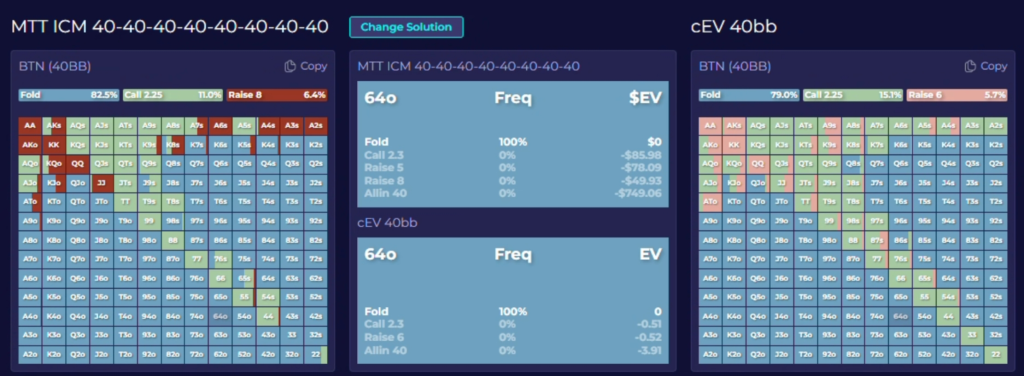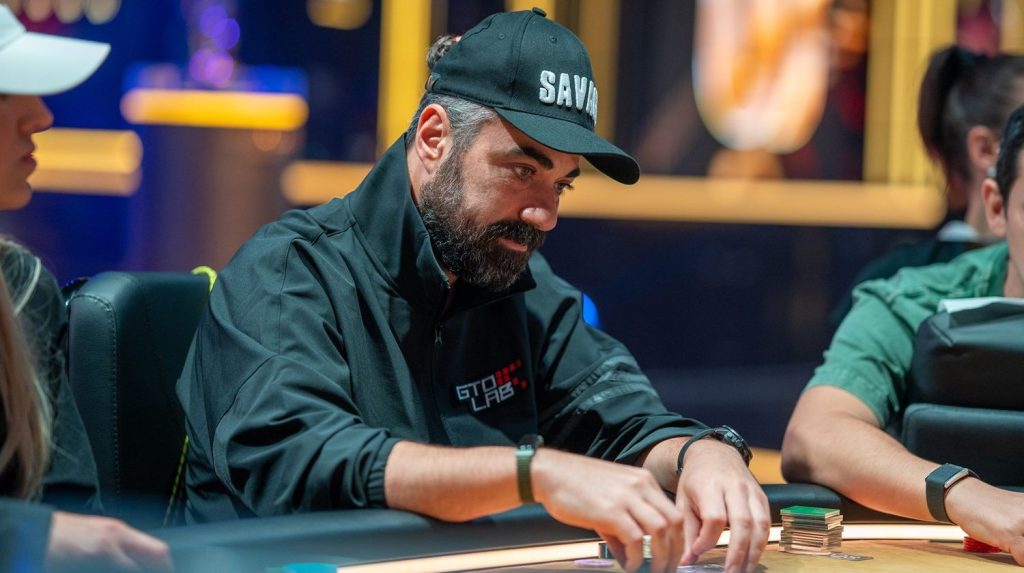Understanding Preflop 3-Bet Sizing Differences Between ChipEV and ICM Scenarios
When stacks average 40 big blinds with ~100 left, preflop 3-bet sizing stops behaving like your clean ChipEV sims. ICM pressure pulls strategy toward polarization, raises the value of blockers, and often rewards ending the hand before the flop. If you keep using one tidy size because a ChipEV sim told you to, you’re leaking.

Why ICM 3-Bet Sizes Are Different from ChipEV
In ChipEV sims, solver outputs are based on equal stacks and a simplified assumption that every chip is worth the same, no matter the payout structure. For example, a typical 40bb ChipEV simulation might land on a single, clean 3-bet size like 6bb. These outputs are built around playing against other equally stacked opponents without ICM pressure.
ICM sims, by contrast, factor in payout implications and bubble risk. In a 100-left, in-the-money scenario with an average stack of 40bb, the risk premium becomes noticeable. Because every player in these equal-stack ICM sims holds the average stack size, the model shows an inflated average bubble factor of around 3.9 percent and a risk premium of about 1.17. This skews the solver outputs in ways that reflect real tournament pressure:
- Preflop ranges become more polarized
- Flatting decreases significantly
- 3-bet fold frequencies increase
- High-card blockers become more valuable
- There is more emphasis on ending the hand preflop
Nick Petrangelo explained it this way:
“Each player now has a more polarized preflop shape, with less flatting, more 3-bet folding, more high-card blocker use, less postflop-focused 3-betting shapes, and generally a premium on winning preflop without showdown.”
These dynamics are especially clear in early and middle position battles. For example, in EP vs MP or EP vs EP spots, the solver starts mixing between smaller and larger 3-bet sizes like 5bb and 8bb and shifts toward aggressive, preflop-focused strategies.
Once ranges move toward late position, especially on the button, the solver starts preferring larger 3-bet sizings exclusively. With no risk of being squeezed from behind, players on the button can leverage more polar ranges and use big sizings to maximize EV with both nutted hands and polar bluffs.
If you want a deeper refresher on ICM, check out our What You Need to Know about ICM blog
Practical sizing by position at 40bb
Early and Middle Position. In EP vs MP or EP vs EP, ICM sims tend to mix between a smaller and a bigger size, for example 5bb and 8bb. The shape is more polar and more preflop-focused than ChipEV. You’re threatening stacks sooner and denying more equity.
Late Position, especially Button. With no one behind to squeeze, the model leans into larger 3-bet sizes only, backed by a more polar range that prints when opponents over-fold or call inelasticly.
Why the mix shows up. ICM rewards clean wins and punishes bloated, marginal postflop spots. The strategy shifts from “one good size for a wide range” to “a small size that keeps weak opens honest and a big size that isolates or ends it.”
If you want a plain-English refresher on range construction that sits underneath these choices, this primer pairs well with the topic.
Should You Deviate Against Weaker Players?
When facing recreational players, it often makes sense to shift away from strict GTO output. For example, players sometimes consider:
- Switching to a more linear 3-bet range
Flattening hands like A-x suited and instead 3-betting stronger suited broadways. - Adjusting sizings
If an opponent is a known calling station, making your 3-bet sizings larger could extract more value from their wide, inelastic calling range. - Choosing flatting over 3-betting to keep weaker players in the pot
If a recreational player is in the big blind, it is often better to flat some hands you would normally 3-bet, especially if your goal is to play a multiway pot where you have a postflop edge.
There is also a broader, meta-level consideration. By flatting more and 3-betting less against weaker players, you allow regulars behind you to enter the pot and compete for the same postflop EV. In some spots, it is better to 3-bet wider just to isolate the weaker player and deny other strong opponents a chance to enter the pot.
A Caution About Hand Selection
While tailoring your ranges and sizings against recreational players is a good idea, there is still one core principle that does not change. Your hand still needs to be reasonable for the line you are taking. Expanding your range does not mean punting with garbage. If you are isolating a weaker player, you should still use hands with blockers, equity, or playability that makes sense for your stack depth and position.
As Orpen put it when the topic of looser isolations came up:
“That is always a good idea but you still wanna have reasonable hands in your hand.”
Quick heuristics you can use today
- If a ChipEV node points to one size, expect ICM to split sizes more often, especially in EP battles.
- On the button under ICM, default larger. The model prefers big sizings with a polar shape.
- Versus calling stations, make the 3-bet bigger with value and trim the bluffs.
- When a weak player is trapped in the big blind, weigh flats that keep them in against the risk of inviting tough players.
- Do not relax hand selection standards just because the target is weak.
One useful outside reference
A concise definition and background on ICM check out the Wikipedia on ICM.
